PROBLEMS
WORKING WITH THE FIGURES
Question 6.1
In Figure 6-1,
what do the yellow stars represent?
explain in your own words why the heterozygote is functionally wild type.
Question 6.2
In Figure 6-2, explain how the mutant polypeptide acts as a spoiler and what its net effect on phenotype is.
Question 6.3
In Figure 6-6, assess the allele Vf with respect to the Vby allele: is it dominant? recessive? codominant? incompletely dominant?
Question 6.4
In Figure 6-11,
in view of the position of HPA oxidase earlier in the pathway compared to that of HA oxidase, would you expect people with tyrosinosis to show symptoms of alkaptonuria?
if a double mutant could be found, would you expect tyrosinosis to be epistatic to alkaptonuria?
Question 6.5
In Figure 6-12,
what do the dollar, pound, and yen symbols represent?
why can’t the left-
hand F1 heterozygote synthesize blue pigment?
Question 6.6
In Figure 6-13, explain at the protein level why this heterokaryon can grow on minimal medium.
Question 6.7
In Figure 6-14, write possible genotypes for each of the four snakes illustrated.
Question 6.8
In Figure 6-15,
which panel represents the double mutant?
state the function of the regulatory gene.
in the situation in panel b, would protein from the active protein gene be made?
Question 6.9
In Figure 6-16, if you selfed 10 different F2 pink plants, would you expect to find any white-
Question 6.10
In Figure 6-19,
what do the square/triangular pegs and holes represent?
is the suppressor mutation alone wild type in phenotype?
Question 6.11
In Figure 6-21, propose a specific genetic explanation for individual Q (give a possible genotype, defining the alleles).
BASIC PROBLEMS
Question 6.12
In humans, the disease galactosemia causes mental retardation at an early age. Lactose (milk sugar) is broken down to galactose plus glucose. Normally, galactose is broken down further by the enzyme galactose-
Question 6.13
In humans, PKU (phenylketonuria) is a recessive disease caused by an enzyme inefficiency at step A in the following simplified reaction sequence, and AKU (alkaptonuria) is another recessive disease due to an enzyme inefficiency in one of the steps summarized as step B here:
246

A person with PKU marries a person with AKU. What phenotypes do you expect for their children? All normal, all having PKU only, all having AKU only, all having both PKU and AKU, or some having AKU and some having PKU?
Question 6.14
In Drosophila, the autosomal recessive bw causes a dark brown eye, and the unlinked autosomal recessive st causes a bright scarlet eye. A homozygote for both genes has a white eye. Thus, we have the following correspondences between genotypes and phenotypes:

Construct a hypothetical biosynthetic pathway showing how the gene products interact and why the different mutant combinations have different phenotypes.
Question 6.15
Several mutants are isolated, all of which require compound G for growth. The compounds (A to E) in the biosynthetic pathway to G are known, but their order in the pathway is not known. Each compound is tested for its ability to support the growth of each mutant (1 to 5). In the following table, a plus sign indicates growth and a minus sign indicates no growth.
|
|
Compound tested |
|||||
|---|---|---|---|---|---|---|
|
|
A |
B |
C |
D |
E |
G |
|
Mutant 1 |
− |
− |
− |
+ |
− |
+ |
|
2 |
− |
+ |
− |
+ |
− |
+ |
|
3 |
− |
− |
− |
− |
− |
+ |
|
4 |
− |
+ |
+ |
+ |
− |
+ |
|
5 |
+ |
+ |
+ |
+ |
− |
+ |
What is the order of compounds A to E in the pathway?
At which point in the pathway is each mutant blocked?
Would a heterokaryon composed of double mutants 1,3 and 2,4 grow on a minimal medium? Would 1,3 and 3,4? Would 1,2 and 2,4 and 1,4?
Question 6.16
In a certain plant, the flower petals are normally purple. Two recessive mutations arise in separate plants and are found to be on different chromosomes. Mutation 1 (m1) gives blue petals when homozygous (m1/m1). Mutation 2 (m2) gives red petals when homozygous (m2/m2). Biochemists working on the synthesis of flower pigments in this species have already described the following pathway:

Which mutant would you expect to be deficient in enzyme A activity?
A plant has the genotype M1/m1; M2/m2. What would you expect its phenotype to be?
If the plant in part b is selfed, what colors of progeny would you expect and in what proportions?
Why are these mutants recessive?
Question 6.17
In sweet peas, the synthesis of purple anthocyanin pigment in the petals is controlled by two genes, B and D. The pathway is

What color petals would you expect in a pure-
breeding plant unable to catalyze the first reaction? What color petals would you expect in a pure-
breeding plant unable to catalyze the second reaction? If the plants in parts a and b are crossed, what color petals will the F1 plants have?
What ratio of purple : blue : white plants would you expect in the F2?
Question 6.18
If a man of blood-
Question 6.19
Most of the feathers of erminette fowl are light colored, with an occasional black one, giving a flecked appearance. A cross of two erminettes produced a total of 48 progeny, consisting of 22 erminettes, 14 blacks, and 12 pure whites. What genetic basis of the erminette pattern is suggested? How would you test your hypotheses?
Question 6.20
Radishes may be long, round, or oval, and they may be red, white, or purple. You cross a long, white variety with a round, red one and obtain an oval, purple F1. The F2 shows nine phenotypic classes as follows: 9 long, red; 15 long, purple; 19 oval, red; 32 oval, purple; 8 long, white; 16 round, purple; 8 round, white; 16 oval, white; and 9 round, red.
Provide a genetic explanation of these results. Be sure to define the genotypes and show the constitution of the parents, the F1, and the F2.
Predict the genotypic and phenotypic proportions in the progeny of a cross between a long, purple radish and an oval, purple one.
Question 6.21
In the multiple-
247
Question 6.22
Black, sepia, cream, and albino are coat colors of guinea pigs. Individual animals (not necessarily from pure lines) showing these colors were intercrossed; the results are tabulated as follows, where the abbreviations A (albino), B (black), C (cream), and S (sepia) represent the phenotypes:
|
Cross |
Parental phenotypes |
Phenotypes of progeny |
|||
|---|---|---|---|---|---|
|
B |
S |
C |
A |
||
|
1 |
B × B |
22 |
0 |
0 |
7 |
|
2 |
B × A |
10 |
9 |
0 |
0 |
|
3 |
C × C |
0 |
0 |
34 |
11 |
|
4 |
S × C |
0 |
24 |
11 |
12 |
|
5 |
B × A |
13 |
0 |
12 |
0 |
|
6 |
B × C |
19 |
20 |
0 |
0 |
|
7 |
B × S |
18 |
20 |
0 |
0 |
|
8 |
B × S |
14 |
8 |
6 |
0 |
|
9 |
S × S |
0 |
26 |
9 |
0 |
|
10 |
C × A |
0 |
0 |
15 |
17 |
Deduce the inheritance of these coat colors, and use gene symbols of your own choosing. Show all parent and progeny genotypes.
If the black animals in crosses 7 and 8 are crossed, what progeny proportions can you predict by using your model?
Question 6.23
In a maternity ward, four babies become accidentally mixed up. The ABO types of the four babies are known to be O, A, B, and AB. The ABO types of the four sets of parents are determined. Indicate which baby belongs to each set of parents: (a) AB × O, (b) A × O, (c) A × AB, (d) O × O.
Question 6.24
Consider two blood polymorphisms that humans have in addition to the ABO system. Two alleles LM and LN determine the M, N, and MN blood groups. The dominant allele R of a different gene causes a person to have the Rh+ (rhesus positive) phenotype, whereas the homozygote for r is Rh— (rhesus negative). Two men took a paternity dispute to court, each claiming three children to be his own. The blood groups of the men, the children, and their mother were as follows:
|
Person |
Blood group |
||
|---|---|---|---|
|
husband |
O |
M |
Rh+ |
|
wife’s lover |
AB |
MN |
Rh— |
|
wife |
A |
N |
Rh+ |
|
child 1 |
O |
MN |
Rh+ |
|
child 2 |
A |
N |
Rh+ |
|
child 3 |
A |
MN |
Rh— |
From this evidence, can the paternity of the children be established?
Question 6.25
On a fox ranch in Wisconsin, a mutation arose that gave a “platinum” coat color. The platinum color proved very popular with buyers of fox coats, but the breeders could not develop a pure-
Question 6.26
For several years, Hans Nachtsheim investigated an inherited anomaly of the white blood cells of rabbits. This anomaly, termed the Pelger anomaly, is the arrest of the segmentation of the nuclei of certain white cells. This anomaly does not appear to seriously burden the rabbits.
When rabbits showing the Pelger anomaly were mated with rabbits from a true-
breeding normal stock, Nachtsheim counted 217 offspring showing the Pelger anomaly and 237 normal progeny. What is the genetic basis of the Pelger anomaly? When rabbits with the Pelger anomaly were mated with each other, Nachtsheim found 223 normal progeny, 439 with the Pelger anomaly, and 39 extremely abnormal progeny. These very abnormal progeny not only had defective white blood cells, but also showed severe deformities of the skeletal system; almost all of them died soon after birth. In genetic terms, what do you suppose these extremely defective rabbits represented? Why were there only 39 of them?
What additional experimental evidence might you collect to test your hypothesis in part b?
In Berlin, about 1 human in 1000 shows a Pelger anomaly of white blood cells very similar to that described for rabbits. The anomaly is inherited as a simple dominant, but the homozygous type has not been observed in humans. Based on the condition in rabbits, why do you suppose the human homozygous has not been observed?
Again by analogy with rabbits, what phenotypes and genotypes would you expect among the children of a man and woman who both show the Pelger anomaly?
(Data from A. M. Srb, R. D. Owen, and R. S. Edgar, General Genetics, 2nd ed. W. H. Freeman and Company, 1965.)
Question 6.27
Two normal-
What is unusual about this result?
Provide a genetic explanation for this anomaly.
Provide a test of your hypothesis.
Question 6.28
You have been given a virgin Drosophila female. You notice that the bristles on her thorax are much shorter than normal. You mate her with a normal male (with long bristles) and obtain the following F1 progeny:  short-
short- long-
long- long-
long- short-
short- long-
long- long-
long-
248
Question 6.29
A dominant allele H reduces the number of body bristles that Drosophila flies have, giving rise to a “hairless” phenotype. In the homozygous condition, H is lethal. An independently assorting dominant allele S has no effect on bristle number except in the presence of H, in which case a single dose of S suppresses the hairless phenotype, thus restoring the hairy phenotype. However, S also is lethal in the homozygous (S/S) condition.
What ratio of hairy to hairless flies would you find in the live progeny of a cross between two hairy flies both carrying H in the suppressed condition?
When the hairless progeny are backcrossed with a parental hairy fly, what phenotypic ratio would you expect to find among their live progeny?
Question 6.30
After irradiating wild-
Were the mutations in the two auxotrophs in the same gene in the pathway for synthesizing leucine or in two different genes in that pathway? Explain.
Write the genotype of the two strains according to your model.
What progeny and in what proportions would you predict from crossing the two auxotrophic mutants? (Assume independent assortment.)
Question 6.31
A yeast geneticist irradiates haploid cells of a strain that is an adenine-
(1) prototroph × wild type : progeny all prototrophic
(2) prototroph × wild type : progeny 75% prototrophic, 25% adenine-
Explain the difference between these two types of results.
Write the genotypes of the prototrophs in each case.
What progeny phenotypes and ratios do you predict from crossing a prototroph of type 2 by the original adel auxotroph?
Question 6.32
In roses, the synthesis of red pigment is by two steps in a pathway, as follows:

What would the phenotype be of a plant homozygous for a null mutation of gene P?
What would the phenotype be of a plant homozygous for a null mutation of gene Q?
What would the phenotype be of a plant homozygous for null mutations of genes P and Q?
Write the genotypes of the three strains in parts a, b, and c.
What F2 ratio is expected from crossing plants from parts a and b? (Assume independent assortment.)
Question 6.33
Because snapdragons (Antirrhinum) possess the pigment anthocyanin, they have reddish purple petals. Two pure anthocyaninless lines of Antirrhinum were developed, one in California and one in Holland. They looked identical in having no red pigment at all, manifested as white (albino) flowers. However, when petals from the two lines were ground up together in buffer in the same test tube, the solution, which appeared colorless at first, gradually turned red.
What control experiments should an investigator conduct before proceeding with further analysis?
What could account for the production of the red color in the test tube?
According to your explanation for part b, what would be the genotypes of the two lines?
If the two white lines were crossed, what would you predict the phenotypes of the F1 and F2 to be?
Question 6.34
The frizzle fowl is much admired by poultry fanciers. It gets its name from the unusual way that its feathers curl up, giving the impression that it has been (in the memorable words of animal geneticist F. B. Hutt) “pulled backwards through a knothole.” Unfortunately, frizzle fowl do not breed true: when two frizzles are intercrossed, they always produce 50 percent frizzles, 25 percent normal, and 25 percent with peculiar woolly feathers that soon fall out, leaving the birds naked.
Give a genetic explanation for these results, showing genotypes of all phenotypes, and provide a statement of how your explanation works.
If you wanted to mass-
produce frizzle fowl for sale, which types would be best to use as a breeding pair?
Question 6.35
The petals of the plant Collinsia parviflora are normally blue, giving the species its common name, blue-
249
|
Parents |
F1 |
F2 |
|---|---|---|
|
blue × white |
blue |
101 blue, 33 white |
|
blue × pink |
blue |
192 blue, 63 pink |
|
pink × white |
blue |
272 blue, 121 white, 89 pink |
Explain these results genetically. Define the allele symbols that you use, and show the genetic constitution of the parents, the F1, and the F2 in each cross.
A cross between a certain blue F2 plant and a certain white F2 plant gave progeny of which
 were blue,
were blue,  were pink, and
were pink, and  were white. What must the genotypes of these two F2 plants have been?
were white. What must the genotypes of these two F2 plants have been?
 Unpacking Problem 35
Unpacking Problem 35
What is the character being studied?
What is the wild-
type phenotype? What is a variant?
What are the variants in this problem?
What does “in nature” mean?
In what way would the variants have been found in nature? (Describe the scene.)
At which stages in the experiments would seeds be used?
Would the way of writing a cross “blue × white,” for example, mean the same as “white × blue”? Would you expect similar results? Why or why not?
In what way do the first two rows in the table differ from the third row?
Which phenotypes are dominant?
What is complementation?
Where does the blueness come from in the progeny of the pink × white cross?
What genetic phenomenon does the production of a blue F1 from pink and white parents represent?
List any ratios that you can see.
Are there any monohybrid ratios?
Are there any dihybrid ratios?
What does observing monohybrid and dihybrid ratios tell you?
List four modified Mendelian ratios that you can think of.
Are there any modified Mendelian ratios in the problem?
What do modified Mendelian ratios indicate generally?
What is indicated by the specific modified ratio or ratios in this problem?
Draw chromosomes representing the meioses in the parents in the cross blue × white and representing meiosis in the F1.
Repeat step 22 for the cross blue × pink.
Question 6.36
A woman who owned a purebred albino poodle (an autosomal recessive phenotype) wanted white puppies; so she took the dog to a breeder, who said he would mate the female with an albino stud male, also from a pure stock. When six puppies were born, all of them were black; so the woman sued the breeder, claiming that he replaced the stud male with a black dog, giving her six unwanted puppies. You are called in as an expert witness, and the defense asks you if it is possible to produce black offspring from two pure-
Question 6.37
A snapdragon plant that bred true for white petals was crossed with a plant that bred true for purple petals, and all the F1 had white petals. The F1 was selfed. Among the F2, three phenotypes were observed in the following numbers:
|
white |
240 |
|
solid purple |
61 |
|
spotted purple |
19 |
|
Total |
320 |
Propose an explanation for these results, showing genotypes of all generations (make up and explain your symbols).
A white F2 plant was crossed with a solid purple F2 plant, and the progeny were
|
white |
50% |
|
solid purple |
25% |
|
spotted purple |
25% |
What were the genotypes of the F2 plants crossed?
Question 6.38
Most flour beetles are black, but several color variants are known. Crosses of pure-
|
Cross |
Parents |
F1 |
F2 |
|---|---|---|---|
|
1 |
Br × Y |
Br |
3 Br : 1 Y |
|
2 |
Bl × Br |
Bl |
3 Bl : 1 Br |
|
3 |
Bl × Y |
Bl |
3 Bl : 1 Y |
|
4 |
W × Y |
Bl |
9 Bl : 3 Y : 4 W |
|
5 |
W × Br |
Bl |
9 Bl : 3 Br : 4 W |
|
6 |
Bl × W |
Bl |
9 Bl : 3 Y : 4 W |
250
From these results, deduce and explain the inheritance of these colors.
Write the genotypes of each of the parents, the F1, and the F2 in all crosses.
Question 6.39
Two albinos marry and have four normal children. How is this possible?
Question 6.40
Consider the production of flower color in the Japanese morning glory (Pharbitis nil). Dominant alleles of either of two separate genes (A/− ·b/b or a/a · B/−) produce purple petals. A/− · B/− produces blue petals, and a/a · b/b produces scarlet petals. Deduce the genotypes of parents and progeny in the following crosses:
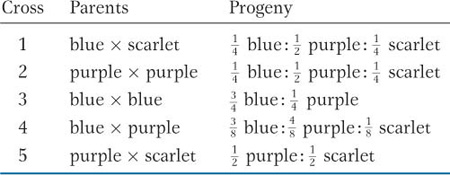
Question 6.41
Corn breeders obtained pure lines whose kernels turn sun red, pink, scarlet, or orange when exposed to sunlight (normal kernels remain yellow in sunlight). Some crosses between these lines produced the following results. The phenotypes are abbreviated O, orange; P, pink; Sc, scarlet; and SR, sun red.
|
Cross |
Phenotypes |
||
|---|---|---|---|
|
Parents |
F1 |
F2 |
|
|
1 |
SR × P |
all SR |
66 SR : 20 P |
|
2 |
O × SR |
all SR |
998 SR : 314 O |
|
3 |
O × P |
all O |
1300 O:429P |
|
4 |
O × Sc |
all Y |
182 Y : 80 O : 58 Sc |
Analyze the results of each cross, and provide a unifying hypothesis to account for all the results. (Explain all symbols that you use.)
Question 6.42
Many kinds of wild animals have the agouti coloring pattern, in which each hair has a yellow band around it.
Black mice and other black animals do not have the yellow band; each of their hairs is all black. This absence of wild agouti pattern is called nonagouti. When mice of a true-
breeding agouti line are crossed with nonagoutis, the F1 is all agouti and the F2 has a 3:1 ratio of agoutis to nonagoutis. Diagram this cross, letting A represent the allele responsible for the agouti phenotype and a, nonagouti. Show the phenotypes and genotypes of the parents, their gametes, the F1, their gametes, and the F2. Another inherited color deviation in mice substitutes brown for the black color in the wild-
type hair. Such brown- agouti mice are called cinnamons. When wild- type mice are crossed with cinnamons, all of the F1 are wild type and the F2 has a 3:1 ratio of wild type to cinnamon. Diagram this cross as in part a, letting B stand for the wild- type black allele and b stand for the cinnamon brown allele. When mice of a true-
breeding cinnamon line are crossed with mice of a true- breeding nonagouti (black) line, all of the F1 are wild type. Use a genetic diagram to explain this result. In the F2 of the cross in part c, a fourth color called chocolate appears in addition to the parental cinnamon and nonagouti and the wild type of the F1. Chocolate mice have a solid, rich brown color. What is the genetic constitution of the chocolates?
Assuming that the A/a and B/b allelic pairs assort independently of each other, what do you expect to be the relative frequencies of the four color types in the F2 described in part d? Diagram the cross of parts c and d, showing phenotypes and genotypes (including gametes).
What phenotypes would be observed in what proportions in the progeny of a backcross of F1 mice from part c with the cinnamon parental stock? With the nonagouti (black) parental stock? Diagram these backcrosses.
Diagram a testcross for the F1 of part c. What colors would result and in what proportions?
Albino (pink-
eyed white) mice are homozygous for the recessive member of an allelic pair C/c, which assorts independently of the A/a and B/b pairs. Suppose that you have four different highly inbred (and therefore presumably homozygous) albino lines. You cross each of these lines with a true- breeding wild- type line, and you raise a large F2 progeny from each cross. What genotypes for the albino lines can you deduce from the following F2 phenotypes? F2 of line
Phenotypes of progeny
Wild type
Black
Cinnamon
Chocolate
Albino
1
87
0
32
0
39
2
62
0
0
0
18
3
96
30
0
0
41
4
287
86
92
29
164
(Adapted from A. M. Srb, R. D. Owen, and R. S. Edgar, General Genetics, 2nd ed. W. H. Freeman and Company, 1965.)
Question 6.43
An allele A that is not lethal when homozygous causes rats to have yellow coats. The allele R of a separate gene that assorts independently produces a black coat. Together, A and R produce a grayish coat, whereas a and r produce a white coat. A gray male is crossed with a yellow female, and the F1 is  yellow,
yellow,  gray,
gray,  black, and
black, and  white. Determine the genotypes of the parents.
white. Determine the genotypes of the parents.
251
Question 6.44
The genotype r/r; p/p gives fowl a single comb, R/−; P/− gives a walnut comb, r/r; P/− gives a pea comb, and R/−; p/p gives a rose comb (see the illustrations). Assume independent assortment.

What comb types will appear in the F1 and in the F2 and in what proportions if single-
combed birds are crossed with birds of a true- breeding walnut strain? What are the genotypes of the parents in a walnut × rose mating from which the progeny are
 rose,
rose,  walnut,
walnut,  pea, and
pea, and  single?
single?What are the genotypes of the parents in a walnut × rose mating from which all the progeny are walnut?
How many genotypes produce a walnut phenotype? Write them out.
Question 6.45
The production of eye-

Explain this mode of inheritance, and show the genotypes of the parents, the F1, and the F2.
Question 6.46
When true-
Question 6.47
Wild-
If a td; su strain is crossed with a genotypically wild-
type strain, what genotypes are expected in the progeny and in what proportions? What will be the ratio of tryptophan-
dependent to tryptophan- independent progeny in the cross of part a?
Question 6.48
Mice of the genotypes A/A; B/B; C/C; D/D; S/S and a/a; b/b; c/c; d/d; s/s are crossed. The progeny are intercrossed. What phenotypes will be produced in the F2 and in what proportions? [The allele symbols stand for the following: A = agouti, a = solid (nonagouti); B = black pigment, b = brown; C = pigmented, c = albino; D = nondilution, d = dilution (milky color); S = unspotted, s = pigmented spots on white background.]
Question 6.49
Consider the genotypes of two lines of chickens: the pure-
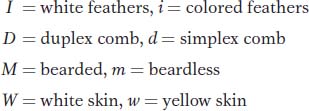
These four genes assort independently. Starting with these two pure lines, what is the fastest and most convenient way of generating a pure line that has colored feathers, has a simplex comb, is beardless, and has yellow skin? Make sure that you show
the breeding pedigree.
the genotype of each animal represented.
how many eggs to hatch in each cross, and why this number.
why your scheme is the fastest and the most convenient.
Question 6.50
The following pedigree is for a dominant phenotype governed by an autosomal allele. What does this pedigree suggest about the phenotype, and what can you deduce about the genotype of individual A?
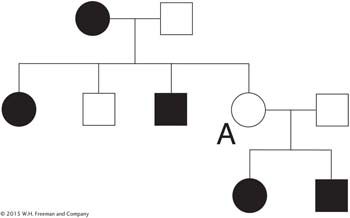
Question 6.51
Petal coloration in foxgloves is determined by three genes. M encodes an enzyme that synthesizes anthocyanin, the purple pigment seen in these petals; m/m produces no pigment, resulting in the phenotype albino with yellowish spots. D is an enhancer of anthocyanin, resulting in a darker pigment; d/d does not enhance. At the third locus, w/w allows pigment deposition in petals, but W prevents pigment deposition except in the spots and so results in the white, spotted phenotype. Consider the following two crosses:
252
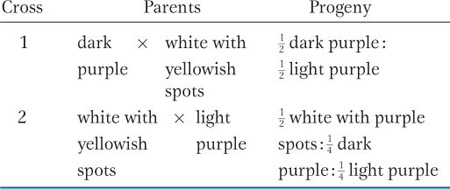
In each case, give the genotypes of parents and progeny with respect to the three genes.
Question 6.52
In one species of Drosophila, the wings are normally round in shape, but you have obtained two pure lines, one of which has oval wings and the other sickle-
|
Parents |
F1 |
||
|---|---|---|---|
|
Female |
Male |
Female |
Male |
|
sickle |
round |
sickle |
sickle |
|
round |
sickle |
sickle |
round |
|
sickle |
oval |
oval |
sickle |
Provide a genetic explanation of these results, defining all allele symbols.
If the F1 oval females from cross 3 are crossed with the F1 round males from cross 2, what phenotypic proportions are expected for each sex in the progeny?
Question 6.53
Mice normally have one yellow band on each hair, but variants with two or three bands are known. A female mouse having one band was crossed with a male having three bands. (Neither animal was from a pure line.) The progeny were

Provide a clear explanation of the inheritance of these phenotypes.
In accord with your model, what would be the outcome of a cross between a three-
banded daughter and a one- banded son?
Question 6.54
In minks, wild types have an almost black coat. Breeders have developed many pure lines of color variants for the mink-
|
Cross |
Parents |
F1 |
F2 |
|---|---|---|---|
|
1 |
wild × platinum |
wild |
18 wild, 5 platinum |
|
2 |
wild × aleutian |
wild |
27 wild, 10 aleutian |
|
3 |
platinum × aleutian |
wild |
133 wild |
|
|
|
|
41 platinum |
|
|
|
|
46 aleutian |
|
|
|
|
17 sapphire (new) |
Devise a genetic explanation of these three crosses. Show genotypes for the parents, the F1, and the F2 in the three crosses, and make sure that you show the alleles of each gene that you hypothesize for every mink.
Predict the F1 and F2 phenotypic ratios from crossing sapphire with platinum and with aleutian pure lines.
Question 6.55
In Drosophila, an autosomal gene determines the shape of the hair, with B giving straight and b giving bent hairs. On another autosome, there is a gene of which a dominant allele I inhibits hair formation so that the fly is hairless (i has no known phenotypic effect).
If a straight-
haired fly from a pure line is crossed with a fly from a pure- breeding hairless line known to be an inhibited bent genotype, what will the genotypes and phenotypes of the F1 and the F2 be? What cross would give the ratio 4 hairless : 3 straight : 1 bent?
Question 6.56
The following pedigree concerns eye phenotypes in Tribolium beetles. The solid symbols represent black eyes, the open symbols represent brown eyes, and the cross symbols (X) represent the “eyeless” phenotype, in which eyes are totally absent.
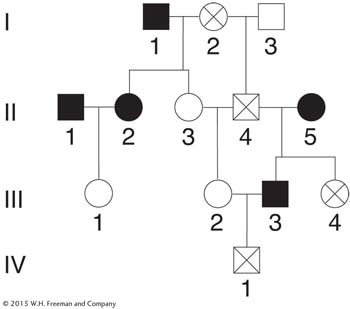
From these data, deduce the mode of inheritance of these three phenotypes.
Using defined gene symbols, show the genotype of beetle II-
3.
253
Question 6.57
A plant believed to be heterozygous for a pair of alleles B/b (where B encodes yellow and b encodes bronze) was selfed, and, in the progeny, there were 280 yellow and 120 bronze plants. Do these results support the hypothesis that the plant is B/b?
Question 6.58
A plant thought to be heterozygous for two independently assorting genes (P/p; Q/q) was selfed, and the progeny were
|
88 P/−; Q/− |
25 p/p; Q/− |
|
32P/−; q/q |
14p/p; q/q |
Do these results support the hypothesis that the original plant was P/p; Q/q?
Question 6.59
A plant of phenotype 1 was selfed, and, in the progeny, there were 100 plants of phenotype 1 and 60 plants of an alternative phenotype 2. Are these numbers compatible with expected ratios of 9:7, 13:3, and 3:1? Formulate a genetic hypothesis on the basis of your calculations.
Question 6.60
Four homozygous recessive mutant lines of Drosophüa melanogaster (labeled 1 through 4) showed abnormal leg coordination, which made their walking highly erratic. These lines were intercrossed; the phenotypes of the F1 flies are shown in the following grid, in which “+” represents wild-
|
|
1 |
2 |
3 |
4 |
|---|---|---|---|---|
|
1 |
− |
+ |
+ |
+ |
|
2 |
+ |
− |
− |
+ |
|
3 |
+ |
− |
− |
+ |
|
4 |
+ |
+ |
+ |
− |
What type of test does this analysis represent?
How many different genes were mutated in creating these four lines?
Invent wild-
type and mutant symbols, and write out full genotypes for all four lines and for the F1 flies. Do these data tell us which genes are linked? If not, how could linkage be tested?
Do these data tell us the total number of genes taking part in leg coordination in this animal?
Question 6.61
Three independently isolated tryptophan-
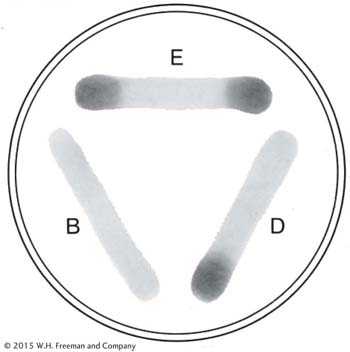
Do you think complementation has a role?
Briefly explain the pattern of luxuriant growth.
Draw the enzymatic steps that are defective in mutants trpB, trpD, and trpE in order in the tryptophan-
synthesizing pathway. Why was it necessary to add a small amount of tryptophan to the medium to demonstrate such a growth pattern?
CHALLENGING PROBLEMS
Question 6.62
A pure-

Propose an explanation for these results, and show the genotypes of the P, F1, and F2 generations.
Question 6.63
Marfan’s syndrome is a disorder of the fibrous connective tissue, characterized by many symptoms, including long, thin digits; eye defects; heart disease; and long limbs. (Flo Hyman, the American volleyball star, suffered from Marfan’s syndrome. She died from a ruptured aorta.)
254
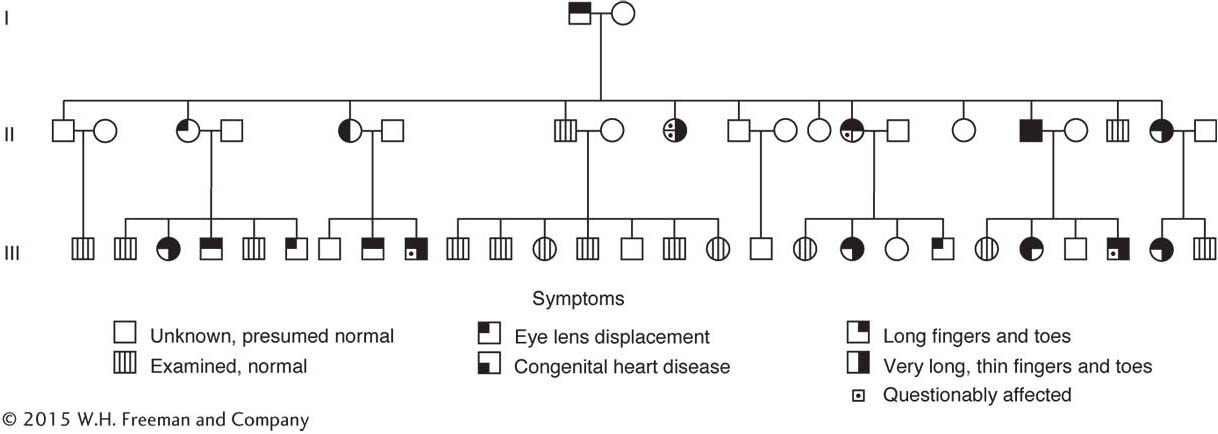
Use the pedigree above to propose a mode of inheritance for Marfan’s syndrome.
What genetic phenomenon is shown by this pedigree?
Speculate on a reason for such a phenomenon.
(Data from J. V. Neel and W. J. Schull, Human Heredity. University of Chicago Press, 1954.)
Question 6.64
In corn, three dominant alleles, called A, C, and R, must be present to produce colored seeds. Genotype A/−; C/−; R/− is colored; all others are colorless. A colored plant is crossed with three tester plants of known genotype. With tester a/a; c/c; R/R, the colored plant produces 50 percent colored seeds; with a/a; C/C; r/r, it produces 25 percent colored; and with A/A; c/c; r/r, it produces 50 percent colored. What is the genotype of the colored plant?
Question 6.65
The production of pigment in the outer layer of seeds of corn requires each of the three independently assorting genes A, C, and R to be represented by at least one dominant allele, as specified in Problem 64. The dominant allele Pr of a fourth independently assorting gene is required to convert the biochemical precursor into a purple pigment, and its recessive allele pr makes the pigment red. Plants that do not produce pigment have yellow seeds. Consider a cross of a strain of genotype A/A; C/C; R/R; pr/pr with a strain of genotype a/a; c/c; r/r; Pr/Pr.
What are the phenotypes of the parents?
What will be the phenotype of the F1?
What phenotypes, and in what proportions, will appear in the progeny of a selfed F1?
What progeny proportions do you predict from the testcross of an F1?
Question 6.66
The allele B gives mice a black coat, and b gives a brown one. The genotype e/e of another, independently assorting gene prevents the expression of B and b, making the coat color beige, whereas E/- permits the expression of B and b. Both genes are autosomal. In the following pedigree, black symbols indicate a black coat, pink symbols indicate brown, and white symbols indicate beige.
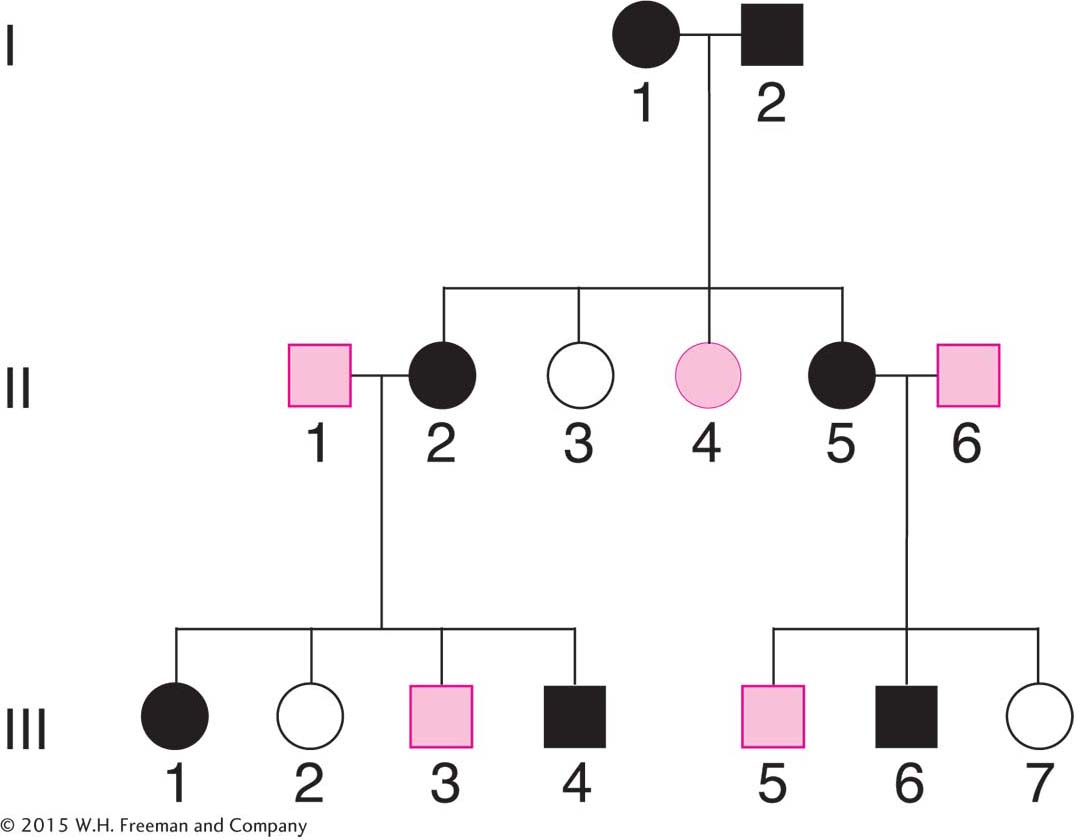
What is the name given to the type of gene interaction in this example?
What are the genotypes of the individual mice in the pedigree? (If there are alternative possibilities, state them.)
Question 6.67
A researcher crosses two white-
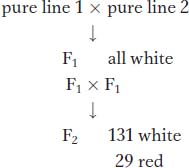
Deduce the inheritance of these phenotypes; use clearly defined gene symbols. Give the genotypes of the parents, F1, and F2.
Predict the outcome of crosses of the F1 with each parental line.
Question 6.68
Assume that two pigments, red and blue, mix to give the normal purple color of petunia petals. Separate bio chemical pathways synthesize the two pigments, as shown in the top two rows of the accompanying diagram. “White” refers to compounds that are not pigments. (Total lack of pigment results in a white petal.) Red pigment forms from a yellow intermediate that is normally at a concentration too low to color petals.
255

A third pathway, whose compounds do not contribute pigment to petals, normally does not affect the blue and red pathways, but, if one of its intermediates (white3) should build up in concentration, it can be converted into the yellow intermediate of the red pathway.
In the diagram, the letters A through E represent enzymes; their corresponding genes, all of which are unlinked, may be symbolized by the same letters.
Assume that wild-
9 purple : 3 green : 4 blue
9 purple : 3 red : 3 blue : 1 white
13 purple : 3 blue
9 purple : 3 red : 3 green : 1 yellow
(Note: Blue mixed with yellow makes green; assume that no mutations are lethal.)
Question 6.69
The flowers of nasturtiums (Tropaeolum majus) may be single (S), double (D), or superdouble (Sd). Superdoubles are female sterile; they originated from a double-
|
Cross |
Parents |
Progeny |
|---|---|---|
|
1 |
pure S × pure D |
All S |
|
2 |
cross 1 F1 × cross 1 F1 |
78 S : 27 D |
|
3 |
pure D × Sd |
112 Sd : 108 D |
|
4 |
pure S × Sd |
8Sd:7S |
|
5 |
pure D × cross 4 Sd progeny |
18 Sd : 19 S |
|
6 |
pure D × cross 4 S progeny |
14 D:16 S |
Using your own genetic symbols, propose an explanation for these results, showing
all the genotypes in each of the six rows.
the proposed origin of the superdouble.
Question 6.70
In a certain species of fly, the normal eye color is red (R). Four abnormal phenotypes for eye color were found: two were yellow (Y1 and Y2), one was brown (B), and one was orange (O). A pure line was established for each phenotype, and all possible combinations of the pure lines were crossed. Flies of each F1 were intercrossed to produce an F2. The F1 and the F2 flies are shown within the following square; the pure lines are given at the top and at the left-
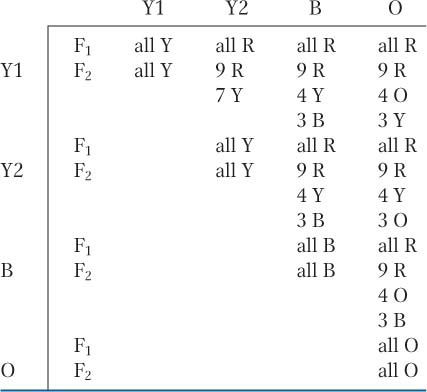
Define your own symbols, and list the genotypes of all four pure lines.
Show how the F1 phenotypes and the F2 ratios are produced.
Show a biochemical pathway that explains the genetic results, indicating which gene controls which enzyme.
Question 6.71
In common wheat, Triticum aestivum, kernel color is determined by multiply duplicated genes, each with an R and an r allele. Any number of R alleles will give red, and a complete lack of R alleles will give the white phenotype. In one cross between a red pure line and a white pure line, the F2 was  red and
red and  white.
white.
How many R genes are segregating in this system?
Show the genotypes of the parents, the F1, and the F2.
Different F2 plants are backcrossed with the white parent. Give examples of genotypes that would give the following progeny ratios in such backcrosses: (1) 1 red : 1 white, (2) 3 red : 1 white, (3) 7 red : 1 white.
What is the formula that generally relates the number of segregating genes to the proportion of red individuals in the F2 in such systems?
Question 6.72
The following pedigree shows the inheritance of deafmutism.
256

Provide an explanation for the inheritance of this rare condition in the two families in generations I and II, showing the genotypes of as many persons as possible; use symbols of your own choosing.
Provide an explanation for the production of only normal persons in generation III, making sure that your explanation is compatible with the answer to part a.
Question 6.73
The pedigree below is for blue sclera (bluish thin outer wall of the eye) and brittle bones.
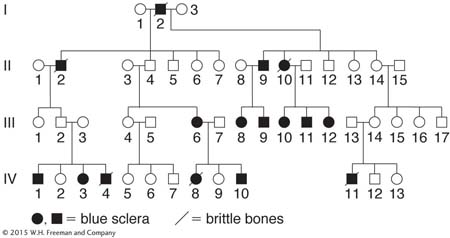
Are these two abnormalities caused by the same gene or by separate genes? State your reasons clearly.
Is the gene (or genes) autosomal or sex-
linked? Does the pedigree show any evidence of incomplete penetrance or expressivity? If so, make the best calculations that you can of these measures.
Question 6.74
Workers of the honeybee line known as Brown (nothing to do with color) show what is called “hygienic behavior”; that is, they uncap hive compartments containing dead pupae and then remove the dead pupae. This behavior prevents the spread of infectious bacteria through the colony. Workers of the Van Scoy line, however, do not perform these actions, and therefore this line is said to be “nonhygienic.” When a queen from the Brown line was mated with Van Scoy drones, all the F1 were nonhygienic. When drones from this F1 inseminated a queen from the Brown line, the progeny behaviors were as follows:

However, when the compartment of dead pupae was uncapped by the beekeeper and the nonhygienic honeybees were examined further, about half the bees were found to remove the dead pupae, but the other half did not.
Propose a genetic hypothesis to explain these behavioral patterns.
Discuss the data in relation to epistasis, dominance, and environmental interaction.
(Note: Workers are sterile, and all bees from one line carry the same alleles.)
Question 6.75
The normal color of snapdragons is red. Some pure lines showing variations of flower color have been found. When these pure lines were crossed, they gave the following results (see the table):
|
Cross |
Parents |
F1 |
F2 |
|---|---|---|---|
|
1 |
orange × yellow |
orange |
3 orange : 1 yellow |
|
2 |
red × orange |
red |
3 red : 1 orange |
|
3 |
red × yellow |
red |
3 red : 1 yellow |
|
4 |
red × white |
red |
3 red : 1 white |
|
5 |
yellow × white |
red |
9 red : 3 yellow : 4 white |
|
6 |
orange × white |
red |
9 red : 3 orange : 4 white |
|
7 |
red × white |
red |
9 red : 3 yellow : 4 white |
Explain the inheritance of these colors.
Write the genotypes of the parents, the F1, and the F2.
Question 6.76
Consider the following F1 individuals in different species and the F2 ratios produced by selfing:

If each F1 were testcrossed, what phenotypic ratios would result in the progeny of the testcross?
Question 6.77
To understand the genetic basis of locomotion in the diploid nematode Caenorhabditis elegans, recessive mutations were obtained, all making the worm “wiggle” ineffectually instead of moving with its usual smooth gliding motion. These mutations presumably affect the nervous or muscle systems. Twelve homozygous mutants were intercrossed, and the F1 hybrids were examined to see if they wiggled. The results were as follows, where a plus sign means that the F1 hybrid was wild type (gliding) and “w” means that the hybrid wiggled.
257
|
|
1 |
2 |
3 |
4 |
5 |
6 |
7 |
8 |
9 |
10 |
11 |
12 |
|---|---|---|---|---|---|---|---|---|---|---|---|---|
|
1 |
w |
+ |
+ |
+ |
w |
+ |
+ |
+ |
+ |
+ |
+ |
+ |
|
2 |
|
w |
+ |
+ |
+ |
w |
+ |
w |
+ |
w |
+ |
+ |
|
3 |
|
|
w |
w |
+ |
+ |
+ |
+ |
+ |
+ |
+ |
+ |
|
4 |
|
|
|
w |
+ |
+ |
+ |
+ |
+ |
+ |
+ |
+ |
|
5 |
|
|
|
|
w |
+ |
+ |
+ |
+ |
+ |
+ |
+ |
|
6 |
|
|
|
|
|
w |
+ |
w |
+ |
w |
+ |
+ |
|
7 |
|
|
|
|
|
|
w |
+ |
+ |
+ |
w |
w |
|
8 |
|
|
|
|
|
|
|
w |
+ |
w |
+ |
+ |
|
9 |
|
|
|
|
|
|
|
|
w |
+ |
+ |
+ |
|
10 |
|
|
|
|
|
|
|
|
|
w |
+ |
+ |
|
11 |
|
|
|
|
|
|
|
|
|
|
w |
w |
|
12 |
|
|
|
|
|
|
|
|
|
|
|
w |
Explain what this experiment was designed to test.
Use this reasoning to assign genotypes to all 12 mutants.
Explain why the phenotype of the F1 hybrids between mutants 1 and 2 differed from that of the hybrids between mutants 1 and 5.
Question 6.78
A geneticist working on a haploid fungus makes a cross between two slow-
|
Spore |
A |
B |
C |
|---|---|---|---|
|
1 |
wild type |
wild type |
spider |
|
2 |
wild type |
spider |
spider |
|
3 |
no germination |
mossy |
mossy |
|
4 |
no germination |
no germination |
mossy |
Devise a model to explain these genetic results, and propose a molecular basis for your model.
Question 6.79
In the nematode C. elegans, some worms have blistered cuticles due to a recessive mutation in one of the bli genes. Someone studying a suppressor mutation that suppressed bli-
How would they determine whether this recessive suppressor mutation would suppress mutations in bli-
4? In other words, what is the genotype of the worms required to answer the question? What cross(es) would they do to make these worms?
What results would they expect in the F2 if
it did act as a suppressor of bli-
4? it did not act as a suppressor of bli-
4?
258